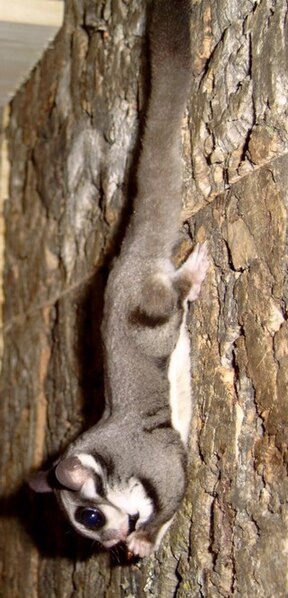 Pygmy Mice, Ground Squirrels, Civets – all sorts of interesting small mammals have found their way into the pet trade and are regularly being bred. Please see Part I of this article for a look at my favorite, the Flying Squirrel. Today I’d like to introduce several others that I’ve enjoyed keeping and learning about.
Pygmy Mice, Ground Squirrels, Civets – all sorts of interesting small mammals have found their way into the pet trade and are regularly being bred. Please see Part I of this article for a look at my favorite, the Flying Squirrel. Today I’d like to introduce several others that I’ve enjoyed keeping and learning about.
Note:Please see Part I of this article for health-related and legal considerations.
Sugar Gliders
Sugar Gliders are the marsupial world’s answer to Flying Squirrels, and perfect examples of convergent evolution – the development of similar traits by unrelated species. I was awed when I first worked with them at the Bronx Zoo – little did I know that they were to become almost “mainstream” pets one day! We are truly lucky that these little Australian natives do so well in captivity, as they offer a peek into the lives of a unique group of animals that would otherwise remain unknown to most of us.
Sugar Glider personalities vary a great deal – even, sometimes, in the same individual…a normally “friendly” little guy once embarrassed me by latching onto my finger while I was rambling on about his good points on live TV. Most, however, tame down well and many become quite responsive pets.
Sugar Gliders are very sociable and should not be kept alone. They are active (very!) by night and do best in tall, multi-level cages.
A number of commercial diets are available, but all require supplementation (please write in for details).
African Pygmy Hedgehogs
Despite their droll appearance and usually calm dispositions, Hedgehogs are relentless predators of insects, scorpions, lizards and other creatures. Pets fare well on commercial Hedgehog food supplemented by mealworms, crickets, waxworms, canned insects, eggs, cottage cheese, baby food and the occasional pink mouse.
Although glass aquariums are often recommended as Hedgehog homes, wire rabbit/guinea pig style hutches and similar cages provide better ventilation and more room, and are preferable. A small animal playpen should be utilized to provide exercise when possible.
Spiny Mice
These North African natives are far stockier (and eat more!) than most mice, and are active by day and night. Spike-like fur renders them unpalatable to many predators – if that doesn’t work, they can also shed their tails.
They fare well on commercial rat/mouse diets, carrots, kale and other vegetables. Certain populations are said to utilize snails as their primary source of water, but, fortunately, captives can do without!
Spiny mice are exceedingly calm, take well to handling, and are quite social – males co-exist up to a point but fighting will break out if they are over-crowded. Cages
designed for rats suit them well.
Degus
These highly social South American relatives of the guinea pig are often over-looked but make exceedingly good pets. They are active by day, take readily to handling, and are always involved in interesting interactions with one another.
 Degus need company, a large,multi-level cage, and temperatures of 70 F or above. The opportunity to bathe in Chinchilla dust is essential.
Degus need company, a large,multi-level cage, and temperatures of 70 F or above. The opportunity to bathe in Chinchilla dust is essential.
Degus are adapted to a high fiber diet…guinea pig pellets, rat chow, hay, carrots and yams should form the basis of their diet.
Further Reading
Sugar Gliders as part of the Extreme Mammals Exhibit at the American Museum of Natural History.
Sugar Glider image referenced from wikipedia and originally posted by Anke Meyring
 That Pet Blog That Pet Place Pet Blog
That Pet Blog That Pet Place Pet Blog


